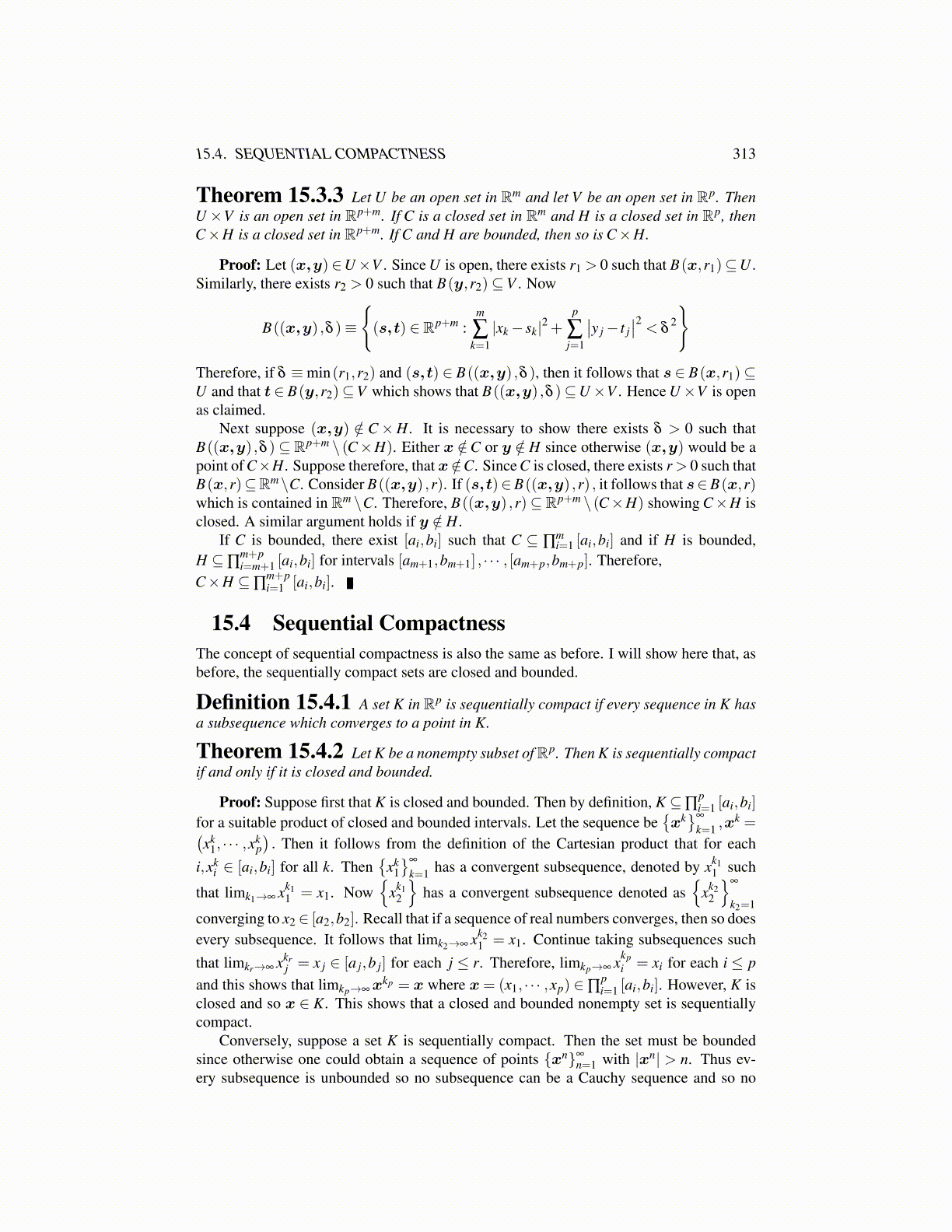
15.4. SEQUENTIAL COMPACTNESS 313
Theorem 15.3.3 Let U be an open set in Rm and let V be an open set in Rp. ThenU ×V is an open set in Rp+m. If C is a closed set in Rm and H is a closed set in Rp, thenC×H is a closed set in Rp+m. If C and H are bounded, then so is C×H.
Proof: Let (x,y)∈U ×V . Since U is open, there exists r1 > 0 such that B(x,r1)⊆U .Similarly, there exists r2 > 0 such that B(y,r2)⊆V . Now
B((x,y) ,δ )≡
{(s,t) ∈ Rp+m :
m
∑k=1
|xk − sk|2 +p
∑j=1
∣∣y j − t j∣∣2 < δ
2
}Therefore, if δ ≡ min(r1,r2) and (s,t) ∈ B((x,y) ,δ ), then it follows that s ∈ B(x,r1)⊆U and that t ∈ B(y,r2)⊆V which shows that B((x,y) ,δ )⊆U ×V . Hence U ×V is openas claimed.
Next suppose (x,y) /∈ C ×H. It is necessary to show there exists δ > 0 such thatB((x,y) ,δ )⊆ Rp+m \ (C×H). Either x /∈C or y /∈ H since otherwise (x,y) would be apoint of C×H. Suppose therefore, that x /∈C. Since C is closed, there exists r > 0 such thatB(x,r)⊆Rm\C. Consider B((x,y) ,r). If (s,t)∈B((x,y) ,r) , it follows that s∈B(x,r)which is contained in Rm \C. Therefore, B((x,y) ,r)⊆Rp+m \ (C×H) showing C×H isclosed. A similar argument holds if y /∈ H.
If C is bounded, there exist [ai,bi] such that C ⊆ ∏mi=1 [ai,bi] and if H is bounded,
H ⊆ ∏m+pi=m+1 [ai,bi] for intervals [am+1,bm+1] , · · · , [am+p,bm+p]. Therefore,
C×H ⊆ ∏m+pi=1 [ai,bi].
15.4 Sequential CompactnessThe concept of sequential compactness is also the same as before. I will show here that, asbefore, the sequentially compact sets are closed and bounded.
Definition 15.4.1 A set K in Rp is sequentially compact if every sequence in K hasa subsequence which converges to a point in K.
Theorem 15.4.2 Let K be a nonempty subset of Rp. Then K is sequentially compactif and only if it is closed and bounded.
Proof: Suppose first that K is closed and bounded. Then by definition, K ⊆ ∏pi=1 [ai,bi]
for a suitable product of closed and bounded intervals. Let the sequence be{xk}∞
k=1 ,xk =(
xk1, · · · ,xk
p). Then it follows from the definition of the Cartesian product that for each
i,xki ∈ [ai,bi] for all k. Then
{xk
1}∞
k=1 has a convergent subsequence, denoted by xk11 such
that limk1→∞ xk11 = x1. Now
{xk1
2
}has a convergent subsequence denoted as
{xk2
2
}∞
k2=1converging to x2 ∈ [a2,b2]. Recall that if a sequence of real numbers converges, then so doesevery subsequence. It follows that limk2→∞ xk2
1 = x1. Continue taking subsequences suchthat limkr→∞ xkr
j = x j ∈ [a j,b j] for each j ≤ r. Therefore, limkp→∞ xkpi = xi for each i ≤ p
and this shows that limkp→∞xkp = x where x= (x1, · · · ,xp) ∈ ∏pi=1 [ai,bi]. However, K is
closed and so x ∈ K. This shows that a closed and bounded nonempty set is sequentiallycompact.
Conversely, suppose a set K is sequentially compact. Then the set must be boundedsince otherwise one could obtain a sequence of points {xn}∞
n=1 with |xn| > n. Thus ev-ery subsequence is unbounded so no subsequence can be a Cauchy sequence and so no